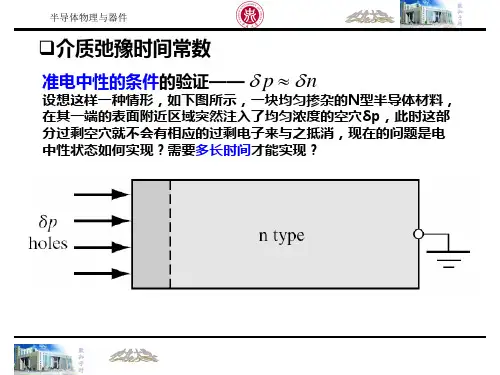半导体物理与器件第六章2
- 格式:ppt
- 大小:1.21 MB
- 文档页数:60


半导体物理与器件(尼曼第四版)答案第一章:半导体材料与晶体1.1 半导体材料的基本特性半导体材料是一种介于导体和绝缘体之间的材料。
它的基本特性包括:1.带隙:半导体材料的价带与导带之间存在一个禁带或带隙,是电子在能量上所能占据的禁止区域。
2.拉伸系统:半导体材料的结构是由原子或分子构成的晶格结构,其中的原子或分子以确定的方式排列。
3.载流子:在半导体中,存在两种载流子,即自由电子和空穴。
自由电子是在导带上的,在外加电场存在的情况下能够自由移动的电子。
空穴是在价带上的,当一个价带上的电子从该位置离开时,会留下一个类似电子的空位,空穴可以看作电子离开后的痕迹。
4.掺杂:为了改变半导体材料的导电性能,通常会对其进行掺杂。
掺杂是将少量元素添加到半导体材料中,以改变载流子浓度和导电性质。
1.2 半导体材料的结构与晶体缺陷半导体材料的结构包括晶体结构和非晶态结构。
晶体结构是指材料具有有序的周期性排列的结构,而非晶态结构是指无序排列的结构。
晶体结构的特点包括:1.晶体结构的基本单位是晶胞,晶胞在三维空间中重复排列。
2.晶格常数是晶胞边长的倍数,用于描述晶格的大小。
3.晶体结构可分为离子晶体、共价晶体和金属晶体等不同类型。
晶体结构中可能存在各种晶体缺陷,包括:1.点缺陷:晶体中原子位置的缺陷,主要包括实际缺陷和自间隙缺陷两种类型。
2.线缺陷:晶体中存在的晶面上或晶内的线状缺陷,主要包括位错和脆性断裂两种类型。
3.面缺陷:晶体中存在的晶面上的缺陷,主要包括晶面位错和穿孔两种类型。
1.3 半导体制备与加工半导体制备与加工是指将半导体材料制备成具有特定电性能的器件的过程。
它包括晶体生长、掺杂、薄膜制备和微电子加工等步骤。
晶体生长是将半导体材料从溶液或气相中生长出来的过程。
常用的晶体生长方法包括液相外延法、分子束外延法和气相外延法等。
掺杂是为了改变半导体材料的导电性能,通常会对其进行掺杂。
常用的掺杂方法包括扩散法、离子注入和分子束外延法等。
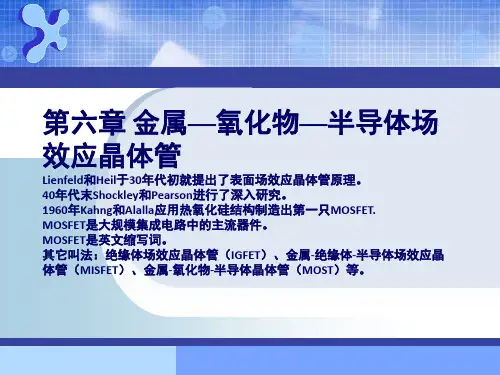
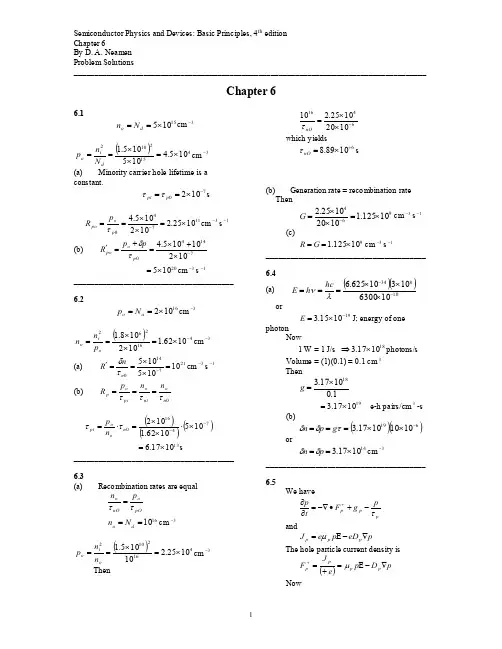
______________________________________________________________________________________Chapter 66.115105⨯==d o N n cm 3-()4152102105.4105105.1⨯=⨯⨯==d i o N n p cm 3- (a) Minority carrier hole lifetime is a constant.70102-⨯==p pt ττs117401025.2102105.4⨯=⨯⨯==-p opo p R τcm 3-s 1- (b)7144010210105.4-⨯+⨯=+='p o po pp R τδ 20105⨯=cm 3-s 1-_______________________________________ 6.216102⨯==a o N p cm 3-()4162621062.1102108.1-⨯=⨯⨯==o i o p n n cm 3-(a) 21714010105105=⨯⨯=='-n n R τδcm 3-s 1- (b)n ontoptop n n p R τττ===()()()741601051062.1102--⨯⋅⨯⨯=⋅=n o o pt n p ττ131017.6⨯=s_______________________________________ 6.3 (a) Recombination rates are equalpOo nO o pn ττ=1610==d o N n cm 3-()41621021025.210105.1⨯=⨯==o i o n n p cm 3-Then641610201025.210-⨯⨯=nO τ which yields61089.8+⨯=nO τs (b) Generation rate = recombination rate Then96410125.110201025.2⨯=⨯⨯=-G cm 3-s 1- (c)910125.1⨯==G R cm 3-s 1-_______________________________________ 6.4 (a) ()()1083410630010310625.6--⨯⨯⨯===λνhch E or191015.3-⨯=E J; energy of one photon Now1 W = 1 J/s 181017.3⨯⇒photons/s Volume = (1)(0.1) = 0.1 cm 3 Then1.01017.318⨯=g191017.3⨯= e-h pairs/cm 3-s (b)()()61910101017.3-⨯⨯===τδδg p n or141017.3⨯==p n δδcm 3-_______________________________________ 6.5We havepp p p g F t p τ-+∙-∇=∂∂+ andp eD p e J p p p ∇-E =μ The hole particle current density is()p D p e J F p ppp ∇-E =+=+μ Now______________________________________________________________________________________ ()p D p F p p p ∇∙∇-E ∙∇=∙∇+μ We can write()E ∙∇+∇∙E =E ∙∇p p p andp p 2∇=∇∙∇ so()p D p p F p p p 2∇-E ∙∇+∇∙E =∙∇+μThen()E ∙∇+∇∙E -=∂∂p p tpp μpp p p g p D τ-+∇+2 We can then write ()E ∙∇+∇∙E -∇p p p D p p μ2tpp g p p ∂∂=-+τ _______________________________________6.6 From Equation (6.18), pp p pg F t p τ-+∙-∇=∂∂+ For steady-state,0=∂∂tpThenp p p R g F -+∙-∇=+0For a one-dimensional case,192010210⨯-=-=+p p p R g dxdF or19108⨯=+dxdF p cm 3-s 1- _______________________________________ 6.7From Equation (6.18),1910200⨯-+-=+dxdF p or19102⨯-=+dxdF p cm 3-s 1-_______________________________________ 6.8We have the continuity equations (1) ()()[]E ∙∇+∇∙E -∇p p p D p p δμδ2()tp p g p p ∂∂=-+δτ and (2) ()()[]E ∙∇+∇∙E +∇n n n D n n δμδ2()t n n g n n ∂∂=-+δτBy charge neutrality,()()p n n p n δδδδδ∇=∇⇒≡= and()()p n δδ22∇=∇ and ()()t p t n ∂∂=∂∂δδ A lso g g g p n ≡=, R np np ≡=ττ Then we have (1) ()()[]E ∙∇+∇∙E -∇p n n D p p δμδ2()tn R g ∂∂=-+δ and (2) ()()[]E ∙∇+∇∙E +∇n n n D n n δμδ2()tn R g ∂∂=-+δ Multiply Equation (1) by n n μ and Equation(2) by p p μ, and add the two equations. We find()()n pD nD n p p n δμμ2∇+()()n n p p n δμμ∇∙E -+ ()()R g p n p n -++μμ______________________________________________________________________________________ ()()tn pn p n ∂∂+=δμμ Divide by ()p n p n μμ+, then()n p n pD nD p n n p p n δμμμμ2∇⎪⎪⎭⎫⎝⎛+++()()n p n n p p n p n δμμμμ∇∙E ⎥⎥⎦⎤⎢⎢⎣⎡+-()()tn R g ∂∂=-+δ Define()pD n D p n D D p n pD nD D p n p n p n n p p n ++=++='μμμμ and ()pn n p p n p n μμμμμ+-='Then we have()()()R g n n D -+∇∙E '+∇'δμδ2()tn∂∂=δ Q.E.D. _______________________________________6.9 p-type material;minority carriers are electrons(a)n μμ=' From Figure 5.3, 1300≅n μcm 2/V-s (b)()()13000259.0=⋅⎪⎭⎫⎝⎛=='n n e kT D D μ 67.33=cm 2/s (c)7010-==n nt ττs15107⨯==a o N p cm 3-()152102107105.1⨯⨯==a i o N n n41021.3⨯=cm 3-pto nt o pn ττ=pt τ15741071010214.3⨯=⨯- so 41018.2⨯=pt τs_______________________________________6.10 For Ge: 13104.2⨯=i n cm 3- 2222i d d o n N N n +⎪⎪⎭⎫⎝⎛+=()21321313104.221042104⨯+⎪⎪⎭⎫ ⎝⎛⨯+⨯=1310124.5⨯=cm 3-()1313213210124.110124.5104.2⨯=⨯⨯==o i o n n p cm 3- (a) We have:3900=n μcm 2/V-s, 101=n D cm 2/s1900=p μcm 2/V-s, 2.49=p D cm 2/s For very, very low injection, ()p D n D p n D D D p n p n ++='()()()()()()()1313131310124.12.4910124.510110124.110124.52.49101⨯+⨯⨯+⨯= 2.54=cm 2/s and()pn n p p n p n μμμμμ+-='()()()()()()()1313131310124.1190010124.5390010124.510124.119003900⨯+⨯⨯-⨯=1340-=cm 2/V-s (b)For holes, 60102-⨯==p pt ττs For electrons,______________________________________________________________________________________p nt p nττ=6131310210124.110124.5-⨯⨯=⨯ntτ61012.9-⨯=⇒nt τs_______________________________________ 6.11p e n e p n μμσ+= W ith excess carriersn n n o δ+= and p p p o δ+=For an n-type semiconductor, we can write p p n δδδ≡= Then()()p p e p n e o p o n δμδμσ+++= or()()p e p e n e p n o p o n δμμμμσ+++= so()()p e p n δμμσ+=∆In steady-state, pO g p τδ'= So that()()pO p n g e τμμσ'+=∆_______________________________________ 6.12 (a) 1610==a o N p cm 3-()41621021025.210105.1⨯=⨯==o i o p n n cm 3- ()()p p e n n e o p o n δμδμσ+++= ()n e p e p n o p δμμμ++≅ Now ()0/01n t n e g p n ττδδ--'==()()()0/7201105108n t e τ---⨯⨯=()0/141104n t eτ--⨯=cm 3-Then σ()()()161910380106.1-⨯= ()()380900106.119+⨯+-()()0/141104n t e τ--⨯⨯ ()0/10819.0608.0n t e τσ--+= (Ω-cm)1- (b) (i)()608.00=σ(Ω-cm)1-(ii)()690.0=∞σ(Ω-cm)1-_______________________________________ 6.13 (a) For 6100-≤≤t s, ()0/01p t p e g p n ττδδ--'==()()()0/8211105104p t e τ---⨯⨯=()()0/141102p t e τ--⨯= cm 3-At 610-=t s,()()()86105/10146110210--⨯---⨯=e p δ14102⨯=cm 3-Then for 610-≥t s,()()6/1014102p t ep τδ---⨯=cm 3-(b)15105⨯=o n cm 3-()p e n e p n o n δμμμσ++=For 6100-≤≤t s,()()()15191057500106.1⨯⨯=-σ ()()3107500106.119+⨯+-()()0/141102p t eτ--⨯⨯()0/1250.00.6p t eτ--+=(Ω-cm)1-For 610-≥t s,()6/10250.00.6p t eτσ---+=(Ω-cm)1-_______________________________________ 6.14R V I =; ALR σ=______________________________________________________________________________________V L A I ⋅=⇒σFor 1515102108⨯+⨯=+=a d I N N N1610=cm 3- Then, 1300≅n μcm 2/V-s400≅p μcm 2/V-s()p e n e p n o n δμμμσ++≅where 0/0p t p e g p ττδ-'=()()0/720105108p t e τ--⨯⨯= 0/14104p t e τ-⨯=cm 3- ()()()1515191021081300106.1⨯-⨯⨯=-σ()()4001300106.119+⨯+-()0/14104p t e τ-⨯⨯ 0/109.0248.1p t e τσ-+= []()()05.01010109.0248.15/0--+=p t e I τ 0/431018.210496.2p t e τ---⨯+⨯= Aor 0/218.0496.2p t e I τ-+=mA_______________________________________6.151516106102⨯-⨯=-=d a o N N p 16104.1⨯=cm 3-(a)0n g p n τδδ'==021********n τ⨯=⨯ 70105.2-⨯=⇒n τs (b)()0/01n t n eg p n ττδδ--'==()0/141105n t e τ--⨯=()0/71401105.2105n t n e n R ττδ---⨯⨯==' ()not e τ/211102--⨯=cm 3-s 1- (c)(i)()()0/1414110510541n t e τ--⨯=⨯⎪⎭⎫ ⎝⎛()801019.73333.1ln -⨯==n t τs(ii) ()()0/1414110510521n t e τ--⨯=⨯⎪⎭⎫ ⎝⎛ ()701073.12ln -⨯==n t τs (iii)()()0/1414110510543n t e τ--⨯=⨯⎪⎭⎫ ⎝⎛ ()701047.34ln -⨯==n t τs(iv)()()()0/1414110510595.0n t e τ--⨯=⨯()701049.720ln -⨯==n t τs_______________________________________6.161515102108⨯-⨯=-=a d o N N n 15106⨯=cm 3-()415262104.5106108.1-⨯=⨯⨯==o i o n n p cm 3- (a) 0440104.5104p p o o p R ττ-⨯=⨯⇒= so 801035.1-⨯=p τs (b) ()()82101035.1102-⨯⨯='=p g p τδ 13107.2⨯=cm 3- (c) 801035.1-⨯==p ττs _______________________________________6.17 (a)(i)For 71050-⨯≤≤t s()()0/01p t p e g t p ττδ--'=()()()0/7201105105p t e τ---⨯⨯=()0/141105.2p t eτ--⨯= cm3-At 7105-⨯=t s,()1/1141105.2--⨯=e p δ141058.1⨯=cm 3-For 7105-⨯≥t s()()p Ot et p τδ/1051471058.1-⨯--⨯=cm 3-______________________________________________________________________________________ (ii) ()1471058.1105⨯=⨯-p δcm 3- (b) (i) For 61020-⨯≤≤t s()()0/141105.2p t e t p τδ--⨯= cm3-At 6102-⨯=t s,()()()76105/102141105.2--⨯⨯--⨯=e p δ1410454.2⨯=cm 3-For 6102-⨯≥t s,()()p O t et p τδ/10214610454.2-⨯--⨯=cm 3-(ii)()14610454.2102⨯=⨯-p δcm 3- _______________________________________ 6.18 (a) For 61020-⨯≤≤t s ()0/0n t n e g t n ττδ-'=()()0/72110510n t e τ--⨯= 0/14105n t e τ-⨯=cm 3-At 6102-⨯=t s,()()76105/102141105--⨯⨯-⨯=e n δ121016.9⨯= cm 3-For 6102-⨯≥t s ()()0/121411016.9105n t e n τδ--⨯-⨯=121016.9⨯+()12/141016.9110908.40⨯+-⨯=-n t e τcm 3-(b) (i)()141050⨯=n δcm 3-(ii)()1261016.9102⨯=⨯-n δcm 3- (iii)()14105⨯=∞n δcm 3-_______________________________________ 6.19p-type; minority carriers - electrons()()12000259.0=⎪⎭⎫⎝⎛=n n e kT D μ 08.31=cm 2/s()()[]2/1601008.31-==n n n D L τ310575.5-⨯=cm(a) ()()n L x e x p x n /14102-⨯==δδcm 3-(b)()[]n L x n nn e dx deD dx n d eD J /14102-⨯==δ ()n L x nne L eD /14102-⨯-=()()()()n L x e /3141910575.510208.31106.1---⨯⨯⨯-=n L x n e J /1784.0--=A/cm 2Holes diffuse at same rate as minority carrier electrons, son L x p e J /1784.0-+=A/cm 2_______________________________________ 6.20 (a)p-type; 1410=pO p cm 3-and()61421021025.210105.1⨯=⨯==pO i pOp n n cm 3-(b) Excess minority carrier concentrationpO p n n n -=δ At 0=x , 0=p n so that()61025.200⨯-=-=pO n n δcm 3-(c) For the one-dimensional case,()022=-nOnndx n d D τδδ or()0222=-nLndx n d δδ where nO n n D L τ=2The general solution is of the form⎪⎪⎭⎫⎝⎛++⎪⎪⎭⎫ ⎝⎛-=n n L x B L x A n exp exp δ For ∞→x , n δ remains finite, so0=B .Then the solution is⎪⎪⎭⎫⎝⎛--=n pO L x n n exp δ _____________________________________________________________________________________________________________________________ 6.21()n L x e x n /14105-⨯=δcm 3-where ()()[]2/1601025-==n n n D L τ 3105-⨯=cm()()[]n L x n n n e dxdeD dx n d eD J /14105-⨯==δ()n L x nne L eD /14105-⨯-=()()()()nL x e /3141910*********.1---⨯⨯⨯-=n L x n e J /4.0--=A/cm 2(a) For 0=x ,()141050⨯=n δcm 3- ()4.00-=n J A/cm 2 ()4.00+=p J A/cm 2 (b) For 3105-⨯==n L x cm,()()141141084.1105⨯=⨯=-e L n n δcm 3-()147.04.01-=-=-e L J n n A/cm 2()147.04.01+=+=-e L J n p A/cm 2(c)For 31015-⨯=x cm n L 3=()()133141049.21053⨯=⨯=-e L n n δcm 3-()020.04.033-=-=-e L J n n A/cm 2()020.04.033+=+=-e L J n p A/cm 2_______________________________________6.22n-type, so we have()()02=-E -pO o p ppdx p d dx p d D τδδμδ Assume the solution is of the form()sx A p exp =δ Then()()sx As dxp d exp =δ, ()()sx As dx p d exp 222=δ Substituting into the differential equation()()sx As sx As D o p p exp exp 2E -μ ()0exp =-pOsx A τor012=-E -pOo p p s s D τμDividing by p D , we have 0122=-E -ppop L s D s μ The solution for s is⎥⎥⎥⎦⎤⎢⎢⎢⎣⎡+⎪⎪⎭⎫ ⎝⎛E ±E =22421p o p p o p pL D D s μμ which can be rewritten as⎥⎥⎥⎦⎤⎢⎢⎢⎣⎡+⎪⎪⎭⎫ ⎝⎛E ±E =12212p o p p pop p p D L D L L s μμ Define po p p D L 2E ≡μβThen ⎥⎦⎤⎢⎣⎡+±=211ββpL s In order that p δ0=as +∞→x , use the minus sign for 0>x and the plus sign for0<x . Then the solution is ()x s A p -=exp δ for 0>x ()x s A p +=exp δ for 0<x where⎥⎦⎤⎢⎣⎡+±=±211ββp L s _____________________________________________________________________________________________________________________________ 6.23 Plot_______________________________________6.24 (a) From Equation (6.55)()()022=-E +nO on n ndx n d dx n d D τδδμδ or()()0222=-E +no n n L ndx n d D dx n d δδμδ We have that⎪⎭⎫⎝⎛=ekTD n n μ so we can define ()L e kT D o o nn '≡E =E 1μ Then we can write()()01222=-⋅'+nL ndx n d L dx n d δδδ The solution is of the form()()x n n αδδ-=exp 0 where 0>α Then()()n dxn d δαδ-= and ()()n dxn d δαδ222= Substituting into the differential equation, wefind()()[]0122=--'+nL nn L n δδαδαor0122=-'-nL L ααwhich yields⎥⎥⎦⎤⎢⎢⎣⎡+⎪⎪⎭⎫ ⎝⎛'+'=12212L L L L L n nn α We may note that if 0=E o , then ∞→'Land nL 1=α(b)nO n n D L τ= where ⎪⎭⎫ ⎝⎛=e kT D n n μso ()()1.310259.01200==n D cm 2/s and ()()47104.391051.31--⨯=⨯=n L cmorμ4.39=n L m For 12=E o V/cm, then ()4106.21120259.0-⨯==E ='oe kT L cmand21075.5⨯=αcm 1-(c) Force on the electrons due to the electric field is in the negative x-direction. Therefore, the effective diffusion of the electrons is reduced and the concentration drops off faster with the applied electric field. _______________________________________ 6.25p-type so the minority carriers are electrons and()()()t n n g n n D nO n n ∂∂=-'+∇∙E +∇δτδδμδ2 Uniform illumination means that()()02=∇=∇n n δδ. For ∞=nO τ, we areleft with()g dtn d '=δ which gives 1C t g n +'=δFor 0≤t , 001=⇒=C n δ Thent G n o'=δ for T t ≤≤0 For T t >, 0='g so that()0=dtn d δ AndT G n o'=δ (no recombination) _______________________________________ 6.26______________________________________________________________________________________ n-type, so minority carriers are holes and ()()()t p p g p p D pO p p ∂∂=-'+∇∙E -∇δτδδμδ2 We have ∞=pO τ , 0=E , and()0=∂∂tp δ(steady-state). Then we have ()022='+g dxp d D p δ or ()pD g dx p d '-=22δFor L x L +<<-, oG g '='= constant. Then()1C x D G dx p d p o +'-=δand 2122C x C x D G p po++'-=δ For L x L 3<<, 0='g so we have()022=dx p d δ so that()3C dxp d =δ and 43C x C p +=δFor L x L -<<-3, 0='g so that()022=dx p d δ so that()5C dxp d =δ and 65C x C p +=δThe boundary conditions are: (1) 0=p δ at L x 3+= (2) 0=p δat L x 3-=(3) p δ continuous at L x = (4) p δ continuous at L x -=(5)()dx p d δ continuous at L x = (6) ()dxp d δ continuous at L x -= Applying the boundary conditions, we find()2252x L D G p po -'=δ forL x L +<<-()x L D L G p po-'=3δ for L x L 3<< ()x L D L G p po+'=3δ for L x L -<<-3 _______________________________________6.27 204.080===E L V V/cm ()()60010322025.0-⨯=E =t d p μ 6.390=cm 2/V-s ()()2216t t D pp ∆E =μ()()[]()()62621032161035.9206.390--⨯⨯=42.10=p D cm 2/sWe find02668.06.39042.10==p p D μV This value is very close to 0.0259 for 300=T K._______________________________________ 6.28 (a)Assume that()()⎪⎪⎭⎫ ⎝⎛-=-Dt x Dt t x f 4exp 4,22/1π is the solution to the differential equationt fx f D ∂∂=⎪⎪⎭⎫ ⎝⎛∂∂22 To prove: we can write()⎪⎪⎭⎫ ⎝⎛-⎪⎭⎫ ⎝⎛-=∂∂-Dt x Dt x Dt x f 4exp 42422/1π and()⎪⎪⎭⎫ ⎝⎛-⎢⎣⎡⎪⎭⎫⎝⎛-=∂∂-Dt x Dt x Dt x f 4exp 424222/122π______________________________________________________________________________________ ⎥⎥⎦⎤⎪⎪⎭⎫ ⎝⎛-⎪⎭⎫ ⎝⎛-+Dt x Dt 4exp 422 A lso()⎪⎪⎭⎫ ⎝⎛-⎪⎭⎫ ⎝⎛-⎪⎪⎭⎫ ⎝⎛-=∂∂-Dt x t D x Dt t f 4exp 1442222/1π()⎪⎪⎭⎫ ⎝⎛-⎪⎭⎫ ⎝⎛-+--Dt x t D 4exp 21422/32/1π Substituting the expressions for 22x f∂∂ and t f ∂∂into the differential equation, we find0 = 0.Q.E.D.(b)Considerdx Dt x ⎰+∞∞-⎪⎪⎭⎫ ⎝⎛-4exp 2Let 2x u =, then dx x du ⋅=2 or udu x du dx 22==Let Dta 41= Nowdx Dt x dx Dt x ⎰⎰∞+∞∞-⎪⎪⎭⎫ ⎝⎛-=⎪⎪⎭⎫ ⎝⎛-0224exp 24exp()()du au u du au u -=-=⎰⎰∞∞exp 1exp 2120t D a ππ4==Thent D t D dx Dt x t D πππ444exp 412=⎪⎪⎭⎫ ⎝⎛-⎰+∞∞-1= _______________________________________6.29Plot_______________________________________6.30 (a) ⎪⎪⎭⎫⎝⎛=-i o Fi F n n kT E E ln ()⎪⎪⎭⎫ ⎝⎛⨯⨯=1016105.1104ln 0259.0383225.0=eV(b) ()()7210105102-⨯⨯='==p g p n τδδ 1510=cm 3- ⎪⎪⎭⎫ ⎝⎛+=-i o Fi Fn n n n kT E E δln ()⎪⎪⎭⎫⎝⎛⨯+⨯=101516105.110104ln 0259.0 383865.0=eV ⎪⎪⎭⎫ ⎝⎛+=-i o Fp Fi n p p kT E E δln ()⎪⎪⎭⎫ ⎝⎛⨯≅1015105.110ln 0259.0 28768.0=eV (c) 383225.0383865.0-=-F Fn E E 000640.0=eV or 640.0=meV _______________________________________ 6.31 (a) p-type⎪⎪⎭⎫ ⎝⎛=-i o F Fi n p kT E E ln ()⎪⎪⎭⎫ ⎝⎛⨯⨯=1015105.1105ln 0259.0 or3294.0=-F Fi E E eV (b)______________________________________________________________________________________14105⨯==p n δδcm 3-and ()4152102105.4105105.1⨯=⨯⨯==o i o p n n cm 3-Then⎪⎪⎭⎫⎝⎛+=-i o Fi Fn n n n kT E E δln()⎪⎪⎭⎫⎝⎛⨯⨯+⨯=10144105.1105105.4ln 0259.0 or2697.0=-Fi Fn E E eV and⎪⎪⎭⎫⎝⎛+=-i o Fp Fi n p p kT E E δln()⎪⎪⎭⎫⎝⎛⨯⨯+⨯=101415105.1105105ln 0259.0 or3318.0=-Fp Fi E E eV_______________________________________ 6.32 (a) For n-type,()()Fi F Fi Fn F Fn E E E E E E ---=-⎪⎪⎭⎫⎝⎛-⎪⎪⎭⎫ ⎝⎛+=i o i o n n kT n n n kT ln ln δ ⎪⎪⎭⎫⎝⎛+=o o n n n kT δln So ()⎪⎪⎭⎫⎝⎛⨯+⨯=1515105105ln 0259.000102.0n δ⎪⎭⎫⎝⎛⨯=+⨯0259.000102.0exp 1051051515n δWhich yields 14102⨯≅n δcm 3-(b) ⎪⎪⎭⎫⎝⎛+=-i o Fi Fn n n n kT E E δln ()⎪⎪⎭⎫ ⎝⎛⨯⨯+⨯=101415105.1102105ln 0259.0 33038.0=eV(c) ⎪⎪⎭⎫⎝⎛≅-i Fp Fi n p kT E E δln()⎪⎪⎭⎫⎝⎛⨯⨯=1014105.1102ln 0259.02460.0=eV_______________________________________ 6.33(a) ⎪⎪⎭⎫⎝⎛≅-i Fi Fn n n kT E E δln or ⎥⎦⎤⎢⎣⎡-=kT E E n n Fi Fn i exp δ ()⎥⎦⎤⎢⎣⎡⨯=0259.0270.0exp 105.110141005.5⨯=cm 3-(b)⎪⎪⎭⎫⎝⎛+=-i o Fp Fi n p p kT E E δln()⎪⎪⎭⎫⎝⎛⨯⨯+⨯=101415105.11005.5106ln 0259.0 33618.0=eV (c) (i) ()()F Fi Fp Fi Fp F E E E E E E ---=-⎪⎪⎭⎫⎝⎛-⎪⎪⎭⎫ ⎝⎛+=i o i o n p kT n p p kT ln ln δ ⎪⎪⎭⎫⎝⎛+=o o p p p kT δln (ii) Fp F E E -()⎪⎪⎭⎫⎝⎛⨯⨯+⨯=1514151061005.5106ln 0259.0 310093.2-⨯=eV or 093.2=meV_____________________________________________________________________________________________________________________________ 6.34 (a) (i) ⎪⎪⎭⎫⎝⎛+=-i o Fi Fn n n n kT E E ln ()()()⎪⎪⎭⎫ ⎝⎛⨯=616108.11002.1ln 0259.0 58166.0=eV (ii) ⎪⎪⎭⎫ ⎝⎛≅-i Fp Fi n p kT E E δln ()⎪⎪⎭⎫ ⎝⎛⨯⨯=616108.11002.0ln 0259.047982.0=eV (b) (i) ()⎪⎪⎭⎫⎝⎛⨯⨯=-616108.1101.1ln 0259.0Fi Fn E E58361.0=eV (ii)()⎪⎪⎭⎫⎝⎛⨯⨯=-616108.1101.0ln 0259.0Fp Fi E E52151.0=eV _______________________________________ 6.35Quasi-Fermi level for minority carrier electrons:⎪⎪⎭⎫⎝⎛+=-i o Fi Fn n n n kT E E δln()4162621024.310108.1-⨯=⨯==o i o p n n cm 3-We have()⎪⎭⎫⎝⎛=501014x n δThen()⎥⎦⎤⎢⎣⎡⨯+⨯=--6144108.150101024.3ln x kT E E Fi Fn We findx (μm)(Fi Fn E E -) (eV)0 12 1020 50-0.581 +0.361 +0.379 +0.420 +0.438 +0.462Quasi-Fermi level for holes: we have ⎪⎪⎭⎫ ⎝⎛+=-i o Fp Fi n p p kT E E δln We have 1610=o p cm 3- and p n δδ=. We findx (μm)(Fp Fi E E -) (eV)0 50+0.58115 +0.58140 _______________________________________ 6.36 (a) We can write⎪⎪⎭⎫⎝⎛=-i o F Fi n p kT E E ln and⎪⎪⎭⎫⎝⎛+=-i o Fp Fi n p p kT E E δln so that()()Fp F F Fi Fp Fi E E E E E E -=---⎪⎪⎭⎫⎝⎛-⎪⎪⎭⎫ ⎝⎛+=i o i o n p kT n p p kT ln ln δ or()kT p p p kT E E o o Fp F 01.0ln =⎪⎪⎭⎫⎝⎛+=-δ Then______________________________________________________________________________________()010.101.0exp ==+oop p p δ or⇒=010.0op pδlow injection, so that 12105⨯=p δcm 3-(b)⎪⎪⎭⎫ ⎝⎛≅-i Fi Fn n p kT E E δln()⎪⎪⎭⎫⎝⎛⨯⨯=1012105.1105ln 0259.0 or1505.0=-Fi Fn E E eV_______________________________________6.37Plot_______________________________________6.38(a) ⎪⎪⎭⎫⎝⎛≅-i Fp Fi n p kT E E δln ()⎪⎭⎫ ⎝⎛⨯=10105.1ln 0259.0p δ 1110=p δcm 3-,04914.0=-Fp Fi E E eV1210 10877.0 1310 16841.0 1410 0.22805 1510 0.28768 (b) ⎪⎪⎭⎫⎝⎛+=-i o Fi Fn n n n kT E E δln()⎪⎪⎭⎫⎝⎛⨯+⨯=1016105.1102ln 0259.0n δ 1110=n δcm 3-, 365273.0=-Fi Fn E E eV12100.365274 1310 0.365286 1410 0.36540215100.366536_______________________________________ 6.39 (a)()()()p p C n n C n np N C C R p n i t p n '++'+-=2()()()p p n n n np nO pO i '++'+-=ττ2Let i n p n ='='. For 0==p n nO pO i i nO i pO i n n n n R ττττ+-=+-=2 (b) We had defined the net generation rate as()R R g g R g o o '+-'+=-where o o R g =since these are the thermal equilibrium generation and recombination rates.If 0='g , then R R g '-=- andnOpO i n R ττ+-=' so that nOpO in R g ττ++=-Thus a negative recombination rate implies anet positive generation rate._______________________________________6.40 We have that()()()p p C n n C n np N C C R p n i t p n '++'+-=2()()()i nO i pO i n p n n n np +++-=ττ2If n n n o δ+= and n p p o δ+=, then()()()()i o nO i o pO i o o n n p n n n n n p n n R +++++-++=δτδτδδ2______________________________________________________________________________________ ()()()()i o nO i o pO i o o o o n n p n n n n n p n n p n +++++-+++=δτδτδδ22 If i n n <<δ, we can neglect ()2n δ: also 2i o o n p n =Then()()()i o nO i o pO o o n p n n p n n R ++++=ττδ(a) For n-type; O o p n >>, i o n n >> Then 7101+==pOn R τδs 1-(b) For intrinsic, i o o n p n == Then ()()i nO i pO i n n n n R 222ττδ+=or ⇒⨯+=+=--771051011nO pO n R ττδ 61067.1+⨯=nR δs 1- (c) For p-type; o o n p >>, i o n p >>Then6710210511+-⨯=⨯==nO n R τδs 1- _______________________________________ 6.41 (a) From Equation (6.56) ()022=-'+pO p p g dx p d D τδδSolution is of the form⎪⎪⎭⎫⎝⎛++⎪⎪⎭⎫ ⎝⎛-+'=p p pO L x B L x A g p exp exp τδAt +∞=x , pO g p τδ'= so that 0=B , Then⎪⎪⎭⎫⎝⎛-+'=p pO L x A g p exp τδ We have()()00===x x p p s dx p d D δδ We can write()p x L A dx p d -==0δ and ()A g p pO x +'==τδ0Then ()A g s L AD pO pp+'=-τSolving for A , we find s L D g s A pp pO +'-=τThe excess concentration is then()⎥⎥⎦⎤⎢⎢⎣⎡⎪⎪⎭⎫⎝⎛-⋅+-'=p p p pO L x s L D s g p exp 1τδ where ()()37101010--===pO p p D L τcm Now()()7211010-=p δ ()⎥⎥⎦⎤⎢⎢⎣⎡⎪⎪⎭⎫ ⎝⎛-⋅+-⨯-p L x s s exp 101013 or ⎥⎥⎦⎤⎢⎢⎣⎡⎪⎪⎭⎫ ⎝⎛-⋅+-=p L x s s p exp 10110414δ (i) For 0=s , 1410=p δcm 3- (ii) For 2000=s cm/s,⎥⎥⎦⎤⎢⎢⎣⎡⎪⎪⎭⎫ ⎝⎛--=p L x p exp 167.011014δ (iii) For ∞=s ,⎥⎥⎦⎤⎢⎢⎣⎡⎪⎪⎭⎫ ⎝⎛--=p L x p exp 11014δ______________________________________________________________________________________ (b) (i) For 0=s , ()14100=p δcm 3-(ii) For 2000=s cm/s,()1410833.00⨯=p δcm 3- (iii) For ∞=s , ()00=p δ _______________________________________6.42 ()()710525-⨯==nO n n D L τ4104.35-⨯=cm(a) At 0=x ,()()1572110105102=⨯⨯='-nO g τcm 3- or()15100='=nO g n τδcm 3-For 0>x()()0022222=-⇒=-nnO n L ndx n d n dx n d D δδτδδ The solution is of the form ⎪⎪⎭⎫ ⎝⎛++⎪⎪⎭⎫ ⎝⎛-=n n L x B L x A n exp exp δ At 0=x , ()B A n n +==0δδ At W x =,⎪⎪⎭⎫⎝⎛++⎪⎪⎭⎫ ⎝⎛-==n n L W B L W A n exp exp 0δ Solving these two equations, we find()()()n n L W L W n A 2exp 12exp 0+-+-=δand ()()n L W n B 2exp 10+-=δSubstituting into the general solution, we find()⎥⎥⎦⎤⎢⎢⎣⎡⎪⎪⎭⎫ ⎝⎛--⎪⎪⎭⎫ ⎝⎛+=n n L W L W n n exp exp 0δδ()()⎪⎭⎪⎬⎫⎪⎩⎪⎨⎧⎥⎦⎤⎢⎣⎡---⎥⎦⎤⎢⎣⎡-+⨯n n L x W L x W exp exp which can be written as()⎥⎦⎤⎢⎣⎡⎥⎦⎤⎢⎣⎡-=n n L W L x W n n sinh sinh 0δδ where ()15100=n δcm 3- and μ4.35=n L m (b) If ∞=nO τ, we have ()022=dx n d δ so the solution is of the form D Cx n +=δ Applying the boundary conditions, we find()⎥⎦⎤⎢⎣⎡-=W x n n 10δδ _______________________________________6.43For ∞=pO τ, we have()022=dxp d δ So the solution is of the formB Ax p +=δ At W x = ()()W x W x p p s dx p d D ===-δδor()B AW s A D p +=-which yields()sW D sAB p +-=At 0=x , the flux of excess holes is()A D dxp d D p x p-=-==01910δso that1819101010-=-=A cm 4-and()⎪⎭⎫⎝⎛+=+=W s sW s B 101010101818 The solution is now______________________________________________________________________________________⎪⎭⎫ ⎝⎛+-=s x W p 101018δ(a)For ∞=s ,()x p -⨯=-418102010δ cm 3- Then()dxp d eD J p p δ-= ()()()181********.1-⨯-=- or6.1=p J A/cm 2 (b)For 3102⨯=s cm/s,()x p -⨯=-418107010δ cm 3- A lso6.1=p J A/cm 2_______________________________________ 6.44For 0<<-x W()022='+on G dxn d D δ so that()1C x D G dx n d no +'-=δ and2122C x C x D G n no++'-=δ For W x <<0,()022=dx n d δ so that43C x C n +=δThe boundary conditions are (1) 0=s at W x -= so that()0=-=Wx dx n d δ (2) ∞=s at W x += so that ()0=W n δ(3) n δ continuous at 0=x(4) ()dxn d δ continuous at 0=x Applying the boundary conditions, we findn o D W G C C '-==31 and noD W G C C 242'+==Then for 0<<-x W()22222W W x x D G n no +--'=δand for W x +<<0()x W D WG n no -'=δ_______________________________________ 6.45Plot_______________________________________ 6.48 (a) GaAs:Ω=⨯==-66101022I V R ()ALR σ∆= and ()p e p n δμμσ+=∆()()13821010510510⨯=⨯='=-p g p τδcm 3-For 1610=d N cm 3-, from Figure 5.3, 7000≅n μcm 2/V-s,310≅p μcm 2/V-s()()()13191053107000106.1⨯+⨯=∆-σ 05848.0=(Ω-cm)1- Let μ20=W mThen ()()441041020--⨯⨯==W d A 81080-⨯=cm 2So ()()86108005848.010-⨯==L RWhich yields 21068.4-⨯=L cm (b) Silicon:Ω=610R , 13105⨯=p δcm 3- For 1610=d N cm 3-, from Figure 5.3,______________________________________________________________________________________ 1300≅n μcm 2/V-s,410≅p μcm 2/V-s()()()13191054101300106.1⨯+⨯=∆-σ01368.0=(Ω-cm)1- Let μ20=W mThen ()()441041020--⨯⨯==W d A 81080-⨯=cm 2So ()()86108001368.010-⨯==LRWhich yields 21009.1-⨯=L cm_______________________________________。
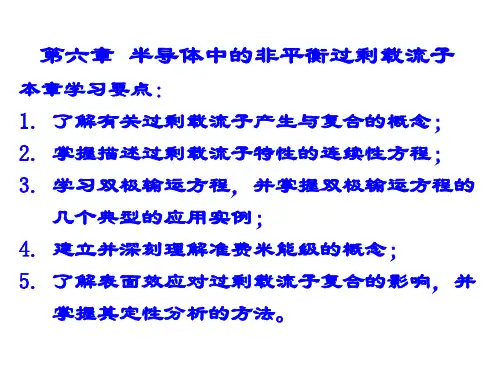

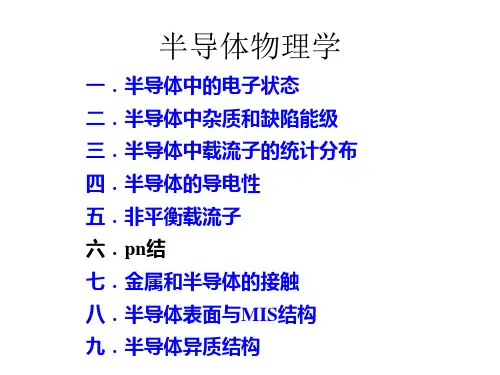
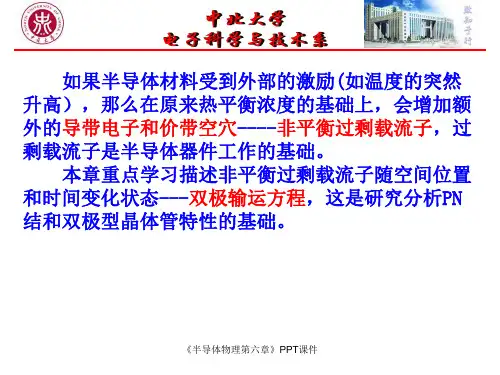

半导体物理与器件第四版答案【篇一:半导体物理第五章习题答案】>1. 一个n型半导体样品的额外空穴密度为1013cm-3,已知空穴寿命为100?s,计算空穴的复合率。
解:复合率为单位时间单位体积内因复合而消失的电子-空穴对数,因此1013u1017cm?3?s ?6100102. 用强光照射n型样品,假定光被均匀吸收,产生额外载流子,产生率为gp,空穴寿命为?,请①写出光照开始阶段额外载流子密度随时间变化所满足的方程;②求出光照下达到稳定状态时的额外载流子密度。
解:⑴光照下,额外载流子密度?n=?p,其值在光照的开始阶段随时间的变化决定于产生和复合两种过程,因此,额外载流子密度随时间变化所满足的方程由产生率gp和复合率u的代数和构成,即 d(?p)?pgp dtd(?p)0,于是由上式得⑵稳定时额外载流子密度不再随时间变化,即 dtppp0gp3. 有一块n型硅样品,额外载流子寿命是1?s,无光照时的电阻率是10??cm。
今用光照射该样品,光被半导体均匀吸收,电子-空穴对的产生率是1022/cm3?s,试计算光照下样品的电阻率,并求电导中少数载流子的贡献占多大比例?解:光照被均匀吸收后产生的稳定额外载流子密度pngp10221061016 cm-3取?n?1350cm2/(v?s),?p?500cm/(v?s),则额外载流子对电导率的贡献2pq(?n??p)?1016?1.6?10?19?(1350?500)?2.96 s/cm无光照时?0?10.1s/cm,因而光照下的电导率0?2.96?0.1?3.06s/cm相应的电阻率 ??110.33cm 3.06少数载流子对电导的贡献为:?p?pq?p??pq?p?gp?q?p代入数据:?p?(p0??p)q?p??pq?p?1016?1.6?10?19?500?0.8s/cm∴p00.80.2626﹪ 3.06即光电导中少数载流子的贡献为26﹪4.一块半导体样品的额外载流子寿命? =10?s,今用光照在其中产生非平衡载流子,问光照突然停止后的20?s时刻其额外载流子密度衰减到原来的百分之几?解:已知光照停止后额外载流子密度的衰减规律为p(t)p0e因此光照停止后任意时刻额外载流子密度与光照停止时的初始密度之比即为t??p(t)e p0t当t?20?s?2?10?5s时20??p(20)e10e20.13513.5﹪ ?p05. 光照在掺杂浓度为1016cm-3的n型硅中产生的额外载流子密度为?n=?p= 1016cm-3。
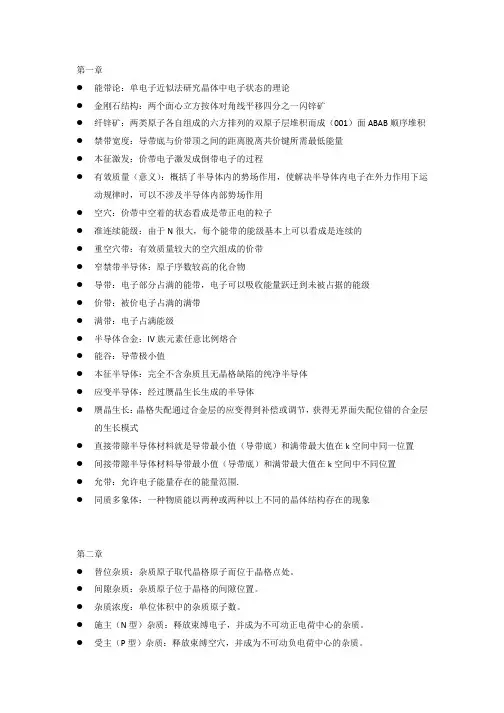
第一章●能带论:单电子近似法研究晶体中电子状态的理论●金刚石结构:两个面心立方按体对角线平移四分之一闪锌矿●纤锌矿:两类原子各自组成的六方排列的双原子层堆积而成(001)面ABAB顺序堆积●禁带宽度:导带底与价带顶之间的距离脱离共价键所需最低能量●本征激发:价带电子激发成倒带电子的过程●有效质量(意义):概括了半导体内的势场作用,使解决半导体内电子在外力作用下运动规律时,可以不涉及半导体内部势场作用●空穴:价带中空着的状态看成是带正电的粒子●准连续能级:由于N很大,每个能带的能级基本上可以看成是连续的●重空穴带:有效质量较大的空穴组成的价带●窄禁带半导体:原子序数较高的化合物●导带:电子部分占满的能带,电子可以吸收能量跃迁到未被占据的能级●价带:被价电子占满的满带●满带:电子占满能级●半导体合金:IV族元素任意比例熔合●能谷:导带极小值●本征半导体:完全不含杂质且无晶格缺陷的纯净半导体●应变半导体:经过赝晶生长生成的半导体●赝晶生长:晶格失配通过合金层的应变得到补偿或调节,获得无界面失配位错的合金层的生长模式●直接带隙半导体材料就是导带最小值(导带底)和满带最大值在k空间中同一位置●间接带隙半导体材料导带最小值(导带底)和满带最大值在k空间中不同位置●允带:允许电子能量存在的能量范围.●同质多象体:一种物质能以两种或两种以上不同的晶体结构存在的现象第二章●替位杂质:杂质原子取代晶格原子而位于晶格点处。
●间隙杂质:杂质原子位于晶格的间隙位置。
●杂质浓度:单位体积中的杂质原子数。
●施主(N型)杂质:释放束缚电子,并成为不可动正电荷中心的杂质。
●受主(P型)杂质:释放束缚空穴,并成为不可动负电荷中心的杂质。
● 杂质电离:束缚电子被释放的过程(N )、束缚空穴被释放的过程(P )。
● 杂质束缚态:杂质未电离时的中性状态。
● 杂质电离能:杂质电离所需的最小能量:● 浅能级杂质:施(受)主能级很接近导(价)带底(顶)。
